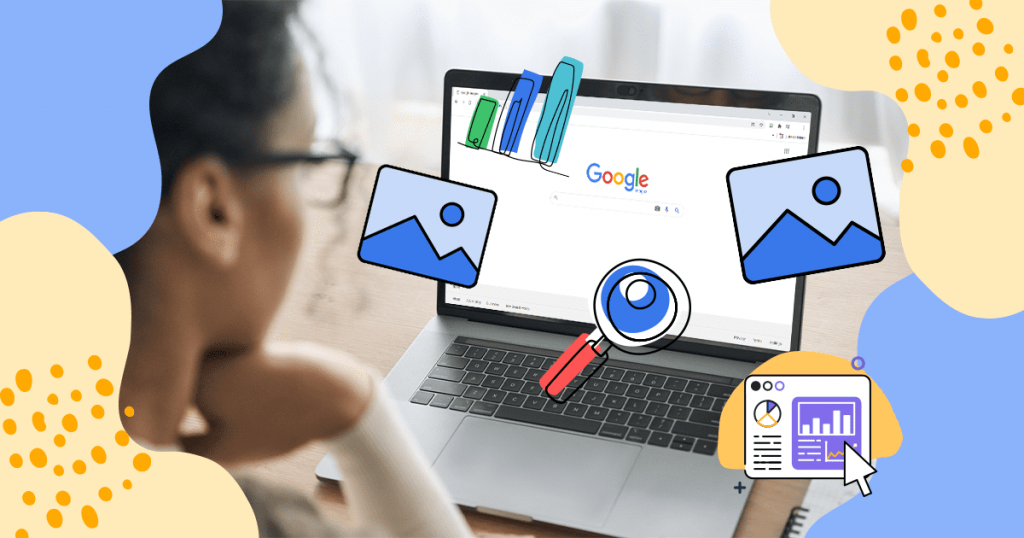Have you ever heard about SEO for Google Images?
Techniques to optimize your visual content to better rank in search results pages. Are you familiar with them?
If your answer is no, it is about time to change that. Especially after a change within Google, that can significantly increase your traffic via images.
Since 1 in every 3 Internet searches involves images, there is a huge potential for network traffic to be achieved with Google Images. If your site is prepared for this, your results can be amazing.
But for this, it is necessary to take a series of steps to adapt your images to Google’s strict requirements.
To help you, we have prepared a complete guide. Here, you will see:
Why use SEO for Google Images on your blog or corporate website?
We can’t lie: working to optimize your media files for search engines is very tiring.
Is it worth it? Is SEO for Google Images rewarding, and will it bring advantages to your Content Marketing strategy?
We believe so, and we’ve got 3 excellent arguments to convince you too!
It’s an additional source of traffic
In 2013, Google announced a change in the Google Images system, implementing a “View Image” button.
If the user clicked there, he was directed to the URL of the image in question, not visiting its source site.
In the months following this change, the general traffic of visits by Google Image dropped a lot. However, in February 2020, the company announced a new change that reversed the situation: there is no longer a “See image” button, which forces users to access the sites to find the full-size media.
The result? An overall increase of 37% in site visits via Google Images.
Impressive, isn’t it?
With this new flow of people being directed to sites, whoever manages to stand out in Google Images can gain an additional traffic source.
It helps your content to go viral
They say that a picture is worth a thousand words. It may not even be true, but visual elements hold incredible power to go viral.
For example, posts with images usually gain 650% more engagement than articles with just words.
More engagement means more chances for content to go viral, increasing your online reach.
But for this to happen, people need to find your images on Google. And that will only happen after optimization — and a lot of work.
Reduce the loading time of your site
Even if you have no interest in capturing traffic through Google Images, you may benefit from this article’s tips.
We’ll talk about this later, but one of the SEO techniques for images involves decreasing files’ size.
With lightweight photos, your page loads faster, which improves the user experience and is rewarded by Google.
In other words: working with SEO for Google Images helps your site as a whole to rank better.
So, are you convinced now? If so, keep reading this article to learn how to better rank your images on the internet!
Now that you have understood the importance of working on SEO for Google Images on your website or blog, the big question is: how do I do this? What are the best practices to ensure a good ranking of your images?
Below, we list the best tips to optimize your images’ ranking, taking into account the elements considered by Google. Check them out!
20 Tips to Improve Your Google Image SEO Rankings
1. Name of the image file
The first element for the ranking of your images starts on your computer, even before the image is uploaded to your servers: the name of the file.
To optimize your images for Google, we need to understand the limitations of search engine crawlers.
They are excellent for understanding text and the relevance of certain content using an algorithm and giving value to keywords.
However, they are still learning to read images. In fact, think a little about this problem: how does one communicate an image’s content to a bot?
For example, imagine that a crawler will read the HTML code of your new article, which talks about the different types of bags available on the market.
You select a beautiful image of a handbag to illustrate the excerpt that explains this type of suitcase to your reader.
However, the file name is “IMG448.png”. What the crawler will have access to is this:
- <img src=”IMG448.png”/>
As you can see, this information is not very useful in explaining the content of the image you used in the article. Now see how the code would look if the file was better named:
- <img src=”brown_leather_handbag.png”/>
Even without seeing the image, we can imagine what it looks like with a name like that, right?
2. Image caption
Did you know that captions under images are read, on average, 300% more than the content of the text itself?
This means that captions are excellent opportunities to engage your readers. And so is Google.
The search engine itself admits it uses captions to extract information to then try to understand the image.
Remember that the crawler can’t see the image? So, any written element will help communicate with the AI what is in that content.
This does not mean that you should place captions on 100% of the images in your articles, but you should use this feature every time you try to rank a specific visual file.
The secret to writing a good caption is to insert information that:
- helps to understand the content of the image;
- includes the keyword that you want to rank;
- complements the content of the article.
Let’s return to our example of the text about different bags. The same photo of a brown leather handbag can illustrate two types of content: one with suitcases for work and another for tourists.
A good caption for an article with tips for travelers would be something like this:
“The traveler can carry a handbag of up to 22 lb on the plane”.
This caption explains the content of the image (it’s a handbag), includes the keyword we want (“handbag”), and complements the content of the article by specifying that it is a photo that relates to handbags and tourism.
3. Alt text
All images on the internet have an ALT attribute, which is used to describe their content.
This is the most important factor in doing SEO for Google Images.
The alt text serves to describe the content of the image in question. It is useful because it helps people with visual impairments (and those who use screen readers) to understand the content, but it is also displayed when the user’s browser cannot load the image file for some reason.
It is also another factor that Google uses to try to understand an image and its relevance to the user.
When writing the content of the alt attribute, it is important to describe what is in the image objectively and briefly, preferably using the keyword we want to rank (but without excesses). See an example:
- bad: <img src=”brown_leatherhandbag.png” alt=””/>
- bad: <img src=”brown_leather_bag.png” alt=”brown leather handbag backpack best brands unmissable prices” />
- good: <img src=”brown_leather_skin bag.png” alt=”brown leather handbag placed in the luggage compartment of an airplane” />
4. Context of the image
According to Google, one of the elements of SEO for Google Images is the context in which the image is used.
The figure must be added to your article in the part where it is most relevant.
This is because Google’s algorithm uses the content of paragraphs near the image as a context to understand its content.
So, if you are talking about “Best Plants for an Apartment”, for example, it is recommended to insert a picture of one of these plants in context.
The same picture won’t be very useful, nor will it have the same strength if added near paragraphs about “types of pots” or “gardening tools”.
5. URL of the image
Remember when we mentioned the importance of structuring your site’s URL correctly to better rank on Google? The logic is the same when we talk about images.
That’s why the tips we gave before are also useful when we want to rank in Google Images.
The important thing is to organize the URL of your media files logically and concisely, to quickly communicate to the search engine that that is an image and its content.
6. Image engagement
Imagine you search for “children’s backpacks” in Google Images. You start looking at the results, and a specific photo catches your attention at the bottom of the list: it’s a blue backpack with a funny sticker placed on it.
You click on the image, then go to the page where it is hosted to read the article.
A few weeks later, you do the same search and, surprise, that image that used to be at the end of the results, is now on top. What happened?
Basically, your click (and that of many people) informed Google that that image is relevant.
In this case, the funny sticker caught your attention and that of other users, which generated more clicks and relevance to the photo.
That is why it is important to use original and impactful images on your site and optimize them for ranking. Those are the figures that will generate more engagement and rank better.
7. Image dimensions
Test it right now: open a new tab in your browser and look for some image in Google. It could be, for example, “puppies”.

Have you noticed any patterns other than the fact that all the photos are extremely cute?
If you paid attention, you might have noticed that the vast majority of the images shown have more or less the same dimensions.
Google tends to favor rectangular images, in proportions like 16:9 or 4:3.
This makes dimensions like 1366 x 768 (16:9) or 720 x 480 (4:3) rank better than images totally out of pattern (like something very horizontal or very vertical).
If these dimensions seem familiar to you, it’s because they are: 16:9 and 4:3 formats are usually used in video resolutions such as TVs, movies, and on YouTube itself.
8. File size
You already know that the loading time of a page is an essential factor for ranking it on Google. The slower it is, the worse the positioning.
The faster, the better.
What you may not already know is that the images on a page are the main factor influencing its loading time.
This means that lightweight images rank better than larger files, which creates the need to compress and reduce your media’s file size.
There are tools to help you do this work. The most famous is Photoshop, by Adobe, but it is a paid software.
Check below a list of free alternatives that do the same job:
9. Image Metadata
Every image has a certain amount of information stored in it, usually generated by the device that captured it.
A photo taken with a camera stores information such as exposure time, the aperture size of the shutter, whether you used a flash or not, etc.
This information is called metadata and is useful for many things, but it is not very important if we are not talking about the technical aspects of photography.
That’s why it’s vital to clean up these metadata that aren’t so important to you, decrease their size, and make your loading time faster.
You can do this very easily:
- click with the right button on the image file on your computer, going to Properties;

- then, go to Details. You will find an option to remove the metadata from the file;

- select one by one or check them all at once, and that’s it!

10. Image sharing
A curious factor that increases the ranking of an image is the number of times the media has been reproduced on other sites via embeds.
Embed is an HTML tag that allows a media file (photo, music, video) from one site to be embedded on another page.
The more this happens with an image, the more Google sees it as relevant and better the ranking becomes.
This is extremely useful when we make infographics and other rich visual materials. A good idea is to facilitate and encourage the embedding of these media in other pages to improve their ranking in Google Images.
11. Positioning the image on the page
We have already mentioned that the image’s position in the article in which it is inserted is essential for your Google ranking.
This is because the paragraphs’ content next to the figure helps to provide context to the search engine.
However, another positioning element ensures a better or worse ranking for an image: whether it is near the top of the page or not.
Google recommends that the main image of your article, the one that best complements your content, should be near the top of your page. This way, it will have the biggest impact on the ranking and will strengthen the keyword you want to highlight.
12. Texts inside the image
Google does not recommend placing a large amount of text inside the image you want to rank. This happens for two reasons:
- search engine crawlers cannot read this content. This makes it “useless” in terms of ranking since it is only available to the user;
- this text is not available to Google machine translation tools, which can worsen the user’s accessibility and experience, which affects the ranking of the page.
The search engine recommends that important text be in HTML, accessible to the crawler, and offering context for the images.
In the case of infographics, it is important to remember that they should be accompanied by articles that have useful information and explain the content, providing the context that Google requests.
13. Responsive Images
For some time now, more searches have been made on Google from mobile devices such as a smartphone or tablet than from desktops.
Mobile devices are no longer the “future of the Internet”, but the present. And if your site is not responsive to suit that, then you have a big ranking problem on your hands.
Sites that are not responsive are penalized by Google and do not appear prominently in mobile devices’ searches. The same happens with images in Google Images.
If you use a version of WordPress higher than 4.4 to manage your website or blog, this is not a problem for you, because this version already formats images as responsive by default.
However, if this is not your case, you should do it manually using the srcset attribute. Google teaches you how to do it on this page!
14. Relevance of the image
The advances in artificial intelligence to identify an image’s content are impressive, but its application in the market is still hesitant. Today, there are only a few bots or algorithms that can “read” a photo.
With Google, it is the same thing, as we have already said. The difference is that the Google Images algorithm can already do some kind of visual search to identify whether or not that image is what the user is looking for.
The system is not very sophisticated, but it is good enough to not show a puppy image (even with all possible SEO optimization) in an “Eiffel Tower” search, for example.
So use the image you really want to use. If it is an article about car sales, use an image of a car and not just any photo of another subject.
15. Structured data
Google Images uses the structured data system to create certain “stamps of prominence” to optimize the users’ experience.
It works like this: if you make an article from one of the themes compatible with Google stamps, you can use the structured data in your images.
This way, they will earn the stamp and indicate to the user that it is exactly what they are looking for.
Google Images is compatible with 3 types of structured data:
- videos;
- recipes;
- products.
If your image is related to one of these subjects, you can use the structured data to earn the stamp and see your image ranked better on Google Images.
For example: if you have a recipe website specialized in chocolate, you can use the structured data to earn your images the “recipe” stamp.
So if someone searches for “chocolate cake recipe” on Google Images, they will have a greater chance to enter your site because the photo will indicate that it is what the person wants.
16 .Open Graph and Twitter Card
Remember we said that the more your site’s image is incorporated into other pages, the more relevant it is to Google?
Well, it is. If you create quality content, it will be shared organically by your readers on social networks.
This means you can have your images incorporated over and over again with these shares.
To do this, you must correctly set up the meta tags of the images for social networks through Facebook Open Graph and Twitter Card.
17. Image Sitemap
A sitemap is an essential tool for the SEO of your page. It indicates to the Google crawler the hierarchy within your site and how to read its content on a priority basis.
You probably have one of these on your blog or website. But did you know that you can create a unique sitemap for your images?
Google itself recommends this. The search engine encourages and teaches how to create an image sitemap to facilitate the crawler’s work of finding your media files and, of course, ensure a better ranking for your site.
18. SafeSearch
Each time an image or page is marked as negative or blocked by a user, Google marks a “negative dot” for your site’s SEO or the media in question.
As the internet has basically everything in it, it is common for parents to be concerned about the content their children have access to online.
For this, Google created SafeSearch, which filters out materials inappropriate for children from their search results.
Therefore, if an image inappropriate for minors is displayed on a SafeSearch device, that content will be marked as negative and blocked. And this will decrease their overall ranking.
That’s why if your site works with images that are unsuitable for minors, you need to indicate them to Google so that you don’t suffer punishments.
One of the simplest ways to do this is to group all these media in a common URL location.
For example:
- http//www.yoursite.com/adult/image.png
Then, in your image sitemap, indicate to Google that that content is adult.
Another way is to use metadata to mark your pages as adult content. All images there will be filtered by SafeSearch and will not be displayed to users with the system activated, which prevents you from suffering punishment.
19. Image format
Not every image format can be captured by Google Images. Therefore, use the correct format if you want to be ranked properly.
The accepted ones are the following:
- JPEG;
- PNG;
- MBP;
- GIF;
- WebP;
- SVG;
- in-line images.
Formats like TIFF or Raw, most used in professional photography, do not appear in Google Images.
The most used format is JPEG because it has the highest compression capacity and can deliver files with small sizes. However, as a negative point, it does not work with transparencies, such as GIFs and PNGs.
20. General site ranking factors
We have listed so far 20 factors exclusive to SEO for Google Images. But what makes Google’s algorithm so rich and effective is that everything is contextualized.
This means that one element favors or harms others, and the idea is that everything works together to get the best possible result.
That is: your site’s general ranking factors contribute to the performance of the media in Google Images.
If your page is optimized to appear on Google, then you will earn points in image searches. If not, you will have problems getting consistent results with your media.
Remember, as we’ve explored these 20 SEO factors specific to Google Images, it’s crucial to understand that every element is interconnected. The effectiveness of your site’s general ranking factors significantly influences its performance in Google Images searches. For those seeking a comprehensive approach to optimize their online presence, Writer Access offers more than just content creation. Our platform provides smooth integrations to enhance your content creation journey.
Gain access to Storyblocks for a diverse library of free stock photos, simplify image sourcing with Shutterstock, and refine visuals smoothly with Canva—all conveniently within the Writer Access platform. Ready to explore these features and elevate your content game? Take the next step by signing up for our free trial today!


![[ROCK NA] [EBOOK SEO] Complete Guide](https://rockcontent.com/wp-content/uploads/2024/06/banner_Search-Engine-Optimization.png)






